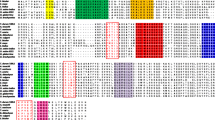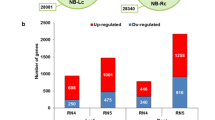Abstract
Key message
Rice rss1 complementation assays show that wheat TdRL1 and RSS1 are true functional homologs. TdRL1 over-expression in Arabidopsis conferred salt stress tolerance and alleviated ROS accumulation.
Abstract
Plants have developed highly flexible adaptive responses to their ever-changing environment, which are often mediated by intrinsically disordered proteins (IDP). RICE SALT SENSITIVE 1 and Triticum durum RSS1-Like 1 protein (TdRL1) are both IDPs involved in abiotic stress responses, and possess conserved D and DEN-Boxes known to be required for post-translational degradation by the APC/Ccdc20 cyclosome. To further understand their function, we performed a computational analysis to compare RSS1 and TdRL1 co-expression networks revealing common gene ontologies, among which those related to cell cycle progression and regulation of microtubule (MT) networks were over-represented. When over-expressed in Arabidopsis, TdRL1::GFP was present in dividing cells and more visible in cortical and endodermal cells of the Root Apical Meristem (RAM). Incubation with the proteasome inhibitor MG132 stabilized TdRL1::GFP expression in RAM cells showing a post-translational regulation. Moreover, immuno-cytochemical analyses of transgenic roots showed that TdRL1 was present in the cytoplasm and within the microtubular spindle of mitotic cells, while, in interphasic cells, it was rather restricted to the cytoplasm with a spotty pattern at the nuclear periphery. Interestingly in cells subjected to stress, TdRL1 was partly relocated into the nucleus. Moreover, TdRL1 transgenic lines showed increased germination rates under salt stress conditions as compared to wild type. This enhanced salt stress tolerance was associated to an alleviation of oxidative damage. Finally, when expressed in the rice rss1 mutant, TdRL1 suppressed its dwarf phenotype upon salt stress, confirming that both proteins are true functional homologs required for salt stress tolerance in cereals.








Similar content being viewed by others
References
Aebi H (1984) Catalase in vitro. Methods Enzymol 105:121–126
Bartels D, Sunkar R (2005) Drought and salt tolerance in plants. Crit Rev Plant Sci 24:23–58
Batzenschlager M, Lermontova I, Schubert V et al (2015) Arabidopsis MZT1 homologs GIP1 and GIP2 are essential for centromere architecture. PNAS 112:8656–8660. https://doi.org/10.1073/pnas.1506351112
Busso D, Delagoutte-Busso B, Moras D (2005) Construction of a set Gateway-based destination vectors for high-throughput cloning and expression screening in Escherichia coli. Anal Biochem 343:313–321
Clough SJ, Bent AF (1998) Floral dip: a simplified method for Agrobacterium-mediated transformation of Arabidopsis thaliana. Plant J 16:735–743
Cromer L, Jolivet S, Horlow C, Chelysheva L et al (2013) Centromeric cohesion is protected twice at meiosis, by SHUGOSHINs at anaphase I and by PATRONUS at interkinesis. Curr Biol 23:2090–2099
Ebel C, Hanin M (2016) Maintenance of meristem activity under stress: is there an interplay of RSS1-like proteins with the RBR pathway? Plant Biol 18:167–170. https://doi.org/10.1111/plb.12424
Haak DC, Fukao T, Grene R et al (2017) Multilevel regulation of abiotic stress responses in plants. Front Plant Sci 8:1564. https://doi.org/10.3389/fpls.2017.01564
Hasan MM, Brocca S, Sacco E et al (2014) A comparative study of Whi5 and retinoblastoma proteins: from sequence and structure analysis to intracellular networks. Front Physiol 4:315
Himmelbach A, Zierold U, Hensel G et al (2007) A set of modular binary vectors for transformation of cereals. Plant Phys 145:1192–1200. https://doi.org/10.1104/pp.107.111575
Hruz T, Laule O, Szabo G et al (2008) Genevestigator V3: a reference expression database for the meta-analysis of transcriptomes. Adv Bioinform.https://doi.org/10.1155/2008/420747
Janski N, Masoud K, Batzenschlager M et al (2012) The GCP3-interacting proteins GIP1 and GIP2 are required for γ-tubulin complex protein localization, spindle integrity, and chromosomal stability. Plant Cell 24:1171–1187.https://doi.org/10.1105/tpc.111.094904
Juraniec M, Heyman J, Schubert V et al (2016) Arabidopsis COPPER MODIFIED RESISTANCE1/PATRONUS1 is essential for growth adaptation to stress and required for mitotic onset control. New Phytol 209:177–191
Karimi M, Inzé D. Depicker A (2002) GATEWAY vectors for Agrobacterium-mediated plant transformation. Trends Plant Sci 7:193–195
Mahjoubi H, Ebel C, Hanin M (2015) Molecular and functional characterization of the durum wheat TdRL1, a member of the conserved Poaceae RSS1-like family that exhibits features of intrinsically disordered proteins and confers stress tolerance in yeast. Funct Integr Genom 15:717–728. https://doi.org/10.1007/s10142-015-0448-x
Ogawa D, Abe K, Miyao A et al (2011) RSS1 regulates the cell cycle and maintains meristematic activity under stress conditions in rice. Nat Commun 2:278. https://doi.org/10.1038/ncomms1279
Ogawa D, Morita H, Hattori T, Takeda S (2012) Molecular characterization of the rice protein RSS1 required for meristematic activity under stressful conditions. Plant Physiol Biochem 61:54–60
Pazos F, Pietrosemoli N, García-Martín JA, Solano R (2013) Protein intrinsic disorder in plants. Front Plant Sci 4:363
Pietrosemoli N, García-Martín JA, Solano R, Pazos F (2013) Genome-wide analysis of protein disorder in Arabidopsis thaliana: implications for plant environmental adaptation. PLoS One 8(2):e55524. https://doi.org/10.1371/journal.pone.0055524
Popov N, Schmitt M, Schulzeck S, Matthies H (1975) Reliable micromethod for determination of the protein content in tissue homogenates. Acta Biol Med Ger 34:1441–1446
Sánchez-Calderón L, Ibarra-Cortés ME, Zepeda-Jazo I (2013) Root development and abiotic stress adaptation. In: Kourosh V (ed) Abiotic stress—plant responses and applications in agriculture. InTech, London. https://doi.org/10.5772/55043
Schneider CA, Rasband WS, Eliceiri KW (2012) NIH image to ImageJ: 25 years of Image analysis. Nat Methods 9:671–675
Shi J, Fu XZ, Peng T et al (2010) Spermine pretreatment confers dehydration tolerance of citrus in vitro plants via modulation of antioxidative capacity and stomatal response. Tree Physiol 30:914–922
Sun X, Rikkerink EHA, Jones WT, Uversky VN (2013) Multifarious roles of intrinsic disorder in proteins illustrate its broad impact on plant biology. Plant Cell 25:38–55. https://doi.org/10.1105/tpc.112.106062
Terada R, Asao H, Iida S (2004) A large-scale Agrobacterium-mediated transformation procedure with a strong positive-negative selection for gene targeting in rice (Oryza sativa L.). Plant Cell Rep 22:653–659
Tian T, Liu Y, Yan H et al (2017) agriGO v2.0: a GO analysis toolkit for the agricultural community, 2017 update. Nucleic Acids Res 45:122–129. https://doi.org/10.1093/nar/gkx382
Velikova V, Yordanov I, Edreva A (2000) Oxidative stress and some antioxidant system in acid rain treated bean plants, protective role of exogenous polyamines. Plant Sci 151:59–66
Zamariola L, De Storme N, Vannerum K et al (2014) SHUGOSHINs and PATRONUS protect meiotic centromere cohesion in Arabidopsis thaliana. Plant J 77:782–794
Author contribution statement
HM performed the experiments (expression data, cloning, transient and stable transformation of tobacco and Arabidopsis, and germination assays). YT and ST performed rice rss1 complementation assays. OBC developed the pIJBP2 vector for rice transformation. ACS and EH helped with confocal microscopy and immuno-cytochemistry experiments and analyses, and reviewed the article. CE, MH, and MEC designed the experiments, searched for funding, supervised the work, and wrote the article.
Acknowledgements
This work has been funded by the Tunisian Higher Ministry of Education and the Centre National de la Recherche Scientifique (CNRS). HM was granted from a French-Tunisian bilateral PHC-Utique program (15G0902/32601ZF). Part of this work was granted by the Swiss National Science Foundation and the ‘Mujeres for Africa’ foundation to CE. Microscopy was carried out at the Strasbourg-Esplanade cellular imaging facilities (CNRS, Université de Strasbourg, Région Alsace, Association de la Recherche sur le Cancer, and Ligue Nationale contre le Cancer).
Author information
Authors and Affiliations
Corresponding author
Ethics declarations
Conflict of interest
The authors declare that the research was conducted in the absence of any commercial or financial relationships that could be construed as a potential conflict of interest.
Additional information
Communicated by Inhwan Hwang.
Electronic supplementary material
Below is the link to the electronic supplementary material.
299_2018_2333_MOESM5_ESM.xlsx
ESM_5: Gene IDs of genes co-expressed with wheat RL1 and rice RSS1, and used to construct the heatmap in Figure 1b, c. (XLSX 12 KB)
299_2018_2333_MOESM8_ESM.pptx
ESM_8: Molecular analyses of rss1 complementation lines. (a) Amplification of TdRL1 transgene in rss1 complementation lines, WT and rss1 mutant. (b) Genomic organization of RSS1 WT and rss1 mutant alleles with the position of the Tos17 insertion and of the primers used for genotyping. (c) PCR genotyping of rss1 complemented lines. (PPTX 309 KB)
Rights and permissions
About this article
Cite this article
Mahjoubi, H., Tamari, Y., Takeda, S. et al. The wheat TdRL1 is the functional homolog of the rice RSS1 and promotes plant salt stress tolerance. Plant Cell Rep 37, 1625–1637 (2018). https://doi.org/10.1007/s00299-018-2333-2
Received:
Accepted:
Published:
Issue Date:
DOI: https://doi.org/10.1007/s00299-018-2333-2




